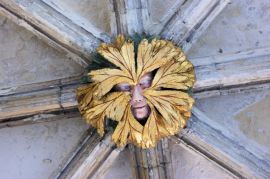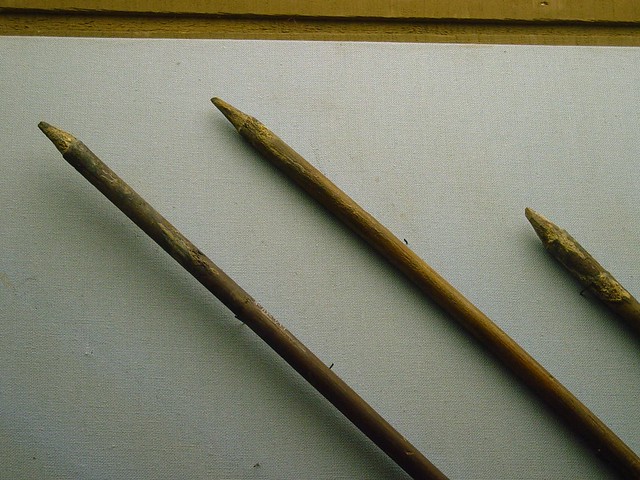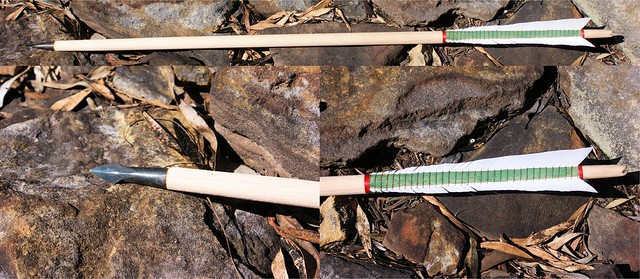Over 3500 arrows were found on the Mary Rose. Statistical analysis of a sample of 1051 complete arrows for length found two peaks in the subset, one at 740mm (draw length 28 inches) and the other at 790mm (draw length 30 inches), the shortest 610mm (24 inches) and the longest was 810mm (32 inches). The ratio of 790mm arrows to 740mm was about 4.5:1. Most of the arrows were made from black poplar, with others made from beech, ash or hazel.
The arrows conform closely in a couple of measures, 12mm (½″) at the head and 10mm (⅜″) at the nock is almost universal, 50mm slit for the horn cross-nock, and a shaftment length of 213-228mm (median 223mm). The feathers (goose or swan) were all about 7 1/2″ long, and they were wrapped with red silk thread. The binding is Z-twist at 4-8 turns per inch (84.1% have 5-6 turns) in all examples examined, however at least one of the arrows on display in the museum during my visits in 2003 and 2006 clearly shows an S-twist.
A number of different shaft profiles were found, each with a different use. This example is barrelled It was used for stability in distance shooting. From the most to least common, the profiles are bobtail (43.1% of the sample – tapering from the shoulder of the head to the nock), parallel (28.5%), barrelled (18.9% – also known as piked, tapering from a maxima about halfway along the shaft in both directions to the head and nock), saddled (5.1% – wide near the shoulder, a reduced diameter near the middle, then wide again and tapering towards the nock) and breasted (4.4% – tapering from the nock to the arrow head).
Points are either MoL Type 16/Jessop M4 swept broadheads or the heavy Tudor bodkins that basically turn the arrow into a cold chisel onna stick.
This reconstruction

This is what you get when you make an arrow based on the tables in the Mary Rose book. It isn’t copied from any one single arrow, but fits within the range of those found on all features. This example is a 30″ barrelled shaft 15mm diameter in the centre, tapering to 10mm at the nock and 12mm at the head. Horn cross-nocked, 7½″ goose fletching ⅝″ at the trailing edge, linen binding, Tudor bodkin head, binding and feathers fastened with multiple coats of rosin/beeswax glue with verdigris added. I will concede it may be a little oversized in the middle, by about 1mm but the report does state that some shrinkage has occurred. I’m sure 400 years in the cold water of the Solent would do that to any of us.
References
Hildred, A. et al., Weapons of Warre – the Armament of the Mary Rose Mary Rose Trust, 2011
The Mary Rose, http://www.maryrose.org/




Hi there!
I am looking into medieval (Arabic) speed shooting and the book I have access to describes a cross-nock. It contains two cuts in the nock instead of one, at a 90° angle to each other in order to accommodate the arrow (4-fletched) on the string in 4 potential nocking directions. This enables the archer to blindly speed-nock. The book does not go into detail of manufacturing of this particular nock though.
Are the Mary-Rose nocks also a cross-90°-angle-cut? If I understand right they are horn?
Thank you very much for your answer!
Cheers Mel
Hi Mel, I’ve seen the Arabic arrows and the the Mary Rose arrows are different to those. The Mary Rose arrows are a straight 3-fletch. A 50mm long slit is cut across the grain at the nock end and a sliver of cow horn is glued in place (buffalo horn is too soft), and the string nock is then cut to a 6-8mm depth at at 90° to the horn sliver. Fletching is glued and bound, with the cock feather at right angles to the string nock and co-planar with the horn.
Here’s one I prepared earlier:

My historical arrow album on Flikr has some other examples from other cultures, but nothing like the Arabic ones you are looking for.
Cheers,
Wayne
Hi Mel,
Theres something I have been looking to find more about for many years. I built 6 Mary Rose replica warbow of best quality Yew to make the draw weights and 36 arrows.
In the process I converted from using dacron to linen to be period accurate.
This meant the arrow nock increased in size to accommodate the Linen string (greater diameter than fast flight dacron).
Many debates ensued, but the fact that someone is using dacron or fast flight already cancels out any claims to historical accuracy.
The other comeback was “Belgian linen trade secrets list in time.”
I dont buy it, all the same materials are available to us now. Hemp, linen, methods of twisting it together, making of loops.
The bow draw weights varied from 80# to 180# I read.
By adding 100# of draw weight, the bowstring would automatically go up in diameter, meaning the archers arrow nock would be larger per individual archer, or smaller.
I never saw anything written about this before. Can you give sample arrow nock sizes of Mary Rose arrows found? Theres over 1,000, so it must vary greatly.
Defending dacron and fastflight makes no sense to me, the string needs to come up to the bow and the arrow. Any current records set with dacron or fast flight font have historical merit. Thus is because they act like a rubber band, not stiff like Linen.
Thank you, William
Linen shoots well, I used it on a 110#
Hi William, Weapons of Warre (p680) says that two studies were done on nock depth and width and attempted to correlate them to draw length. They were inconclusive but do note that nock width must be matched to string diameter.
Mean nock width is 3.09 +/-0.08mm and depth 6.19 +/- 0.14mm but the width varies between 1.8 and 5.3mm with clusters at 3mm, 3.5mm and 4mm.
I’d suggest the 1.8mm wide nocks have been left for the archer to finish, although they all fall at the low end on the nock diameter (7-8.5mm) and have the full range of draw lengths from 740mm-840mm.
Cheers,
Wayne
Since the Mary Rose arrow discovery the Tower of London Inventories from the mid 1300’s have been translated from Latin, Anglo Norman and middle English and give a comprehensive view of bow and arrow manufacture, purchase and distribution which now cast doubt on the purpose of the Mary Rose arrows.
There were only two categories of arrow, the yard long war arrow and everything else. Everything else was all commercial arrows for hunting, target and flight shooting. Almost all, both commercial and military, were made of aspen (Poplar Tremulus). The flights of commercial arrows were whipped (also known as waxed) and in most cases the heads were pinned, bound or heat shrunk on so the arrow could be removed intact from target or prey, these arrows were made to be reusable and could last many years whereas the military arrowsheads were push fit so as to come apart when trying to remove from shields or flesh and unwhipped as they were considered a single use missile.
“In his expenses we find one fletcher paid 6d. a day for 244 days making 300 sheaves
of arrows from arighshaftes from stock, feathers (plumis pro pennatione) purchased
at 8s., wax for 3s. 4d. and a dog skin for 6d., £6 13s. 10d. in total. This total of
45,744 arrows was therefore assembled at a rate of 187 per fletcher per day; no other
source known to the writer gives that degree of detail about the work-rate of a
medieval fletcher.”
This is @12 pence for 24 arrows, no mention of waxed thread and certainly not enough time to whip even 25% of the arrows.
On the other hand we have an order from the Tower for hunting arrows for the King which would be 32’ and have had tanged heads and been whipped @6 shillings for 24 arrows.
I believe the Mary Rose arrows and perhaps the bows were cargo.The ship had been cleared for action with both the main deck and 1st deck amply stacked with weapons and ammunition and you cannot hang a burning piece of tarred hemp or a lime bag on a 28” arrow without sacrificing 35 % distance.